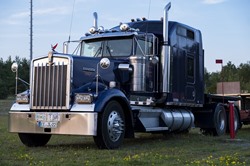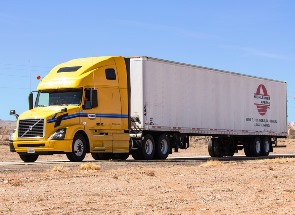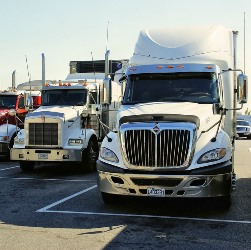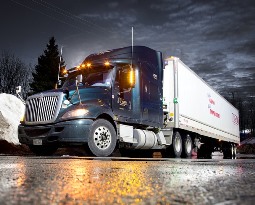How to Select the Best CDL Training School near Franklin Vermont
 Congratulations on your decision to become a truck driver and enroll in a CDL school near Franklin VT. Perhaps it has always been your ambition to hit the open highway while operating a big ole tractor trailer. Or possibly you have done some analysis and have discovered that a career as a truck driver offers excellent wages and flexible work prospects. Regardless of what your reason is, it’s essential to obtain the proper training by selecting the right CDL school in your area. When evaluating your options, there are various factors that you’ll need to examine prior to making your ultimate choice. Location will no doubt be important, especially if you need to commute from your Franklin home. The cost will also be important, but picking a school based exclusively on price is not the ideal method to make sure you’ll receive the right training. Just remember, your goal is to learn the skills and knowledge that will allow you to pass the CDL exams and become a qualified truck driver. So keeping that purpose in mind, just how do you pick a truck driving school? The answer to that question is what we are going to address in the balance of this article. But first, we are going to talk a little bit about which commercial driver’s license you will eventually need.
Congratulations on your decision to become a truck driver and enroll in a CDL school near Franklin VT. Perhaps it has always been your ambition to hit the open highway while operating a big ole tractor trailer. Or possibly you have done some analysis and have discovered that a career as a truck driver offers excellent wages and flexible work prospects. Regardless of what your reason is, it’s essential to obtain the proper training by selecting the right CDL school in your area. When evaluating your options, there are various factors that you’ll need to examine prior to making your ultimate choice. Location will no doubt be important, especially if you need to commute from your Franklin home. The cost will also be important, but picking a school based exclusively on price is not the ideal method to make sure you’ll receive the right training. Just remember, your goal is to learn the skills and knowledge that will allow you to pass the CDL exams and become a qualified truck driver. So keeping that purpose in mind, just how do you pick a truck driving school? The answer to that question is what we are going to address in the balance of this article. But first, we are going to talk a little bit about which commercial driver’s license you will eventually need.
Which Commercial Drivers License Should You Get?
 To drive commercial vehicles lawfully within the USA and Franklin VT, a driver must get a CDL (Commercial Driver’s License). The three classes of licenses that a person can qualify for are Class A, Class B and Class C. Since the subject of this article is how to choose a truck driver school, we will focus on Class A and B licenses. What differentiates each class of CDL is the kind of vehicle that the driver can operate in addition to the GVWR (Gross Vehicle Weight Rating) or GCWR (Gross Combination Weight Rating). Following are short descriptions for the 2 classes.
To drive commercial vehicles lawfully within the USA and Franklin VT, a driver must get a CDL (Commercial Driver’s License). The three classes of licenses that a person can qualify for are Class A, Class B and Class C. Since the subject of this article is how to choose a truck driver school, we will focus on Class A and B licenses. What differentiates each class of CDL is the kind of vehicle that the driver can operate in addition to the GVWR (Gross Vehicle Weight Rating) or GCWR (Gross Combination Weight Rating). Following are short descriptions for the 2 classes.
Class A CDL. A Class A CDL is needed to operate any vehicle that has a GCWR of more than 26,000 lbs., including a towed vehicle of greater than 10,000 lbs. Several of the vehicles that drivers may be able to operate with Class A licenses are:
- Interstate or Intrastate Tractor Trailers
- Trucks with Double or Triple Trailers
- Tanker Trucks
- Livestock Carriers
- Class B and Class C Vehicles
Class B CDL. A Class B Commercial Drivers License is needed to drive single vehicles having a GVWR of more than 26,000 lbs., or a GCWR of more than 26,000 lbs. including a towed vehicle weighing up to 10,000 lbs. Some of the vehicles that drivers may be qualified to operate with Class B licenses are:
- Tractor Trailers
- Dump Trucks
- Cement Mixers
- Large Buses
- Class C Vehicles
Both Class A and Class B CDLs may also need endorsements to drive specific kinds of vehicles, for example school or passenger buses. And a Class A licensee, with the proper needed endorsements, may operate any vehicle that a Class B licensee is authorized to operate.
Click Here to Get Free Information on Truck Driving Schools Near You!
How to Research a CDL School
 After you have decided which Commercial Drivers License you wish to pursue, you can begin the undertaking of evaluating the Franklin VT trucking schools that you are looking at. As already discussed, cost and location will certainly be your initial concerns. But it can’t be stressed enough that they must not be your sole concerns. Other factors, for instance the reputations of the schools or the experience of the instructors are similarly if not more important. So following are several additional things that you need to research while carrying out your due diligence prior to choosing, and particularly paying for, your truck driving training.
After you have decided which Commercial Drivers License you wish to pursue, you can begin the undertaking of evaluating the Franklin VT trucking schools that you are looking at. As already discussed, cost and location will certainly be your initial concerns. But it can’t be stressed enough that they must not be your sole concerns. Other factors, for instance the reputations of the schools or the experience of the instructors are similarly if not more important. So following are several additional things that you need to research while carrying out your due diligence prior to choosing, and particularly paying for, your truck driving training.
Are the Schools Accredited or Certified ? Very few truck driver schools in the Franklin VT area are accredited because of the demanding process and cost to the schools. On the other hand, certification is more typical and is offered by the Professional Truck Driver Institute (PTDI). A school is not required to become certified, but there are a number of advantages. Prospective students know that the training will be of the highest standard, and that they will be given plenty of driving time. For example, PTDI calls for 44 hours of actual driving time, not ride-alongs or simulations. So if a school’s course is certified (the course, not the school is certified), students know that the curriculum and training will fulfill the very high standards set by PTDI.
How Long in Business? One indicator to help determine the quality of a truck driver school is how long it has been in business. A poorly rated or a fly by night school normally will not be in business very long, so longevity is a plus. However, even the best of Franklin VT schools had to begin from their first day of training, so use it as one of several qualifications. You can also learn what the school’s track record is pertaining to successful licensing and employment of its graduates. If a school won’t provide those stats, search elsewhere. The schools should also maintain associations with regional and national trucking companies. Having a large number of contacts not only points to a quality reputation within the industry, but also boosts their job placement program for graduates. It also wouldn’t hurt to contact the Vermont licensing department to make sure that the CDL trucking schools you are reviewing are in compliance.
How Good is the Training? As a minimum requirement, the schools should be licensed in Vermont and employ instructors that are trained and experienced. We will cover more about the teachers in the next section. In addition, the student to instructor ratio should be no higher than 4 to 1. If it’s any greater, then students will not be obtaining the personalized instruction they will need. This is particularly true concerning the one-on-one instruction for behind the wheel training. And be critical of any school that insists it can train you to be a truck driver in a relatively short period of time. Training to be a truck driver and to drive a tractor trailer skillfully requires time. Most Franklin VT schools provide training courses that run from 3 weeks to as long as two months, based on the class of license or kind of vehicle.
How Good are the Teachers? As already mentioned, it’s important that the teachers are trained to teach driving methods and experienced as both instructors and drivers. Even though a number of states have minimum driving time criteria to qualify as a teacher, the more professional driving experience an instructor has the better. It’s also important that the teachers stay current with industry advancements or any new laws or changes in regulations. Assessing instructors might be a little more subjective than other standards, and perhaps the ideal method is to check out the school and speak with the instructors in person. You can also talk to some of the students completing the training and find out if they are happy with the level of instruction and the teacher’s qualification to train them.
Plenty of Driving Time? Most importantly, an excellent truck driving school will furnish lots of driving time to its students. Besides, isn’t that what it’s all about? Driving time is the real time spent behind the wheel operating a truck. While the use of ride-a-longs with other students and simulators are important training methods, they are no substitute for actual driving. The more instruction that a student gets behind the wheel, the better driver she or he will be. Although driving time differs between schools, a reasonable benchmark is a minimum of 32 hours. If the school is PTDI certified, it will furnish a minimum of 44 hours of driving time. Get in touch with the Franklin VT schools you are looking at and find out how much driving time they provide.
Are they Independent or Captive ? You can receive discounted or even free training from some truck driver schools if you enter into an agreement to be a driver for a particular carrier for a defined amount of time. This is called contract training, and the schools that provide it are called captives. So rather than maintaining relationships with a wide range of trucking lines that they can place their graduates with, captives only work with one company. The benefit is receiving free or less expensive training by giving up the flexibility to initially be a driver wherever you choose. Naturally contract training has the potential to reduce your income prospects when starting out. But for many it may be the only way to get affordable training. Just make sure to inquire if the Franklin VT schools you are contemplating are captive or independent so that you can make an informed decision.
Provide CDL Testing Onsite? There are some states that will permit third party CDL testing onsite of trucking schools for its graduates. If onsite testing is permitted in Vermont, find out if the schools you are considering are DMV certified to provide it. One benefit is that it is more convenient than battling with graduates of competing schools for test times at Vermont testing facilities. It is also an indication that the DMV views the approved schools to be of a higher quality.
Are the Class Times Accessible? As earlier mentioned, CDL training is only about one to two months long. With such a short duration, it’s important that the Franklin VT school you select provides flexibility for both the scheduling of classes and the curriculum. For example, if you’re having a hard time learning a particular driving maneuver, then the instructor should be willing to spend more time with you until you have it mastered. And if you’re still holding a job while going to training, then the class scheduling must be flexible enough to accommodate working hours or other obligations.
Is Job Assistance Provided? As soon as you have received your commercial driver’s license after graduating from truck driving school, you will be eager to start your new profession. Verify that the schools you are contemplating have job placement programs. Ask what their job placement percentage is and what average salary their graduates start at. Also, find out which local and national trucking companies their graduates are referred to for hiring. If a school has a lower job placement rate or few Franklin VT employers hiring their grads, it may be a sign to search elsewhere.
Is Financial Assistance Given? Truck driver schools are comparable to colleges and other Franklin VT area trade or technical schools when it comes to loans and other forms of financial assistance being offered. Find out if the schools you are reviewing have a financial aid department, or at a minimum someone who can help you navigate the options and forms that need to be submitted.
Class B Truck Driving Schools Franklin Vermont
 Selecting the ideal trucking school is a critical first step to beginning your new occupation as a local or long distance truck driver. The skills that you will learn at school will be those that mold a new career behind the wheel. There are a number of options available and understanding them is critical if you are going to succeed as an operator. You originally came to our website because of your interest in Class B Truck Driving Schools and wanting information on the topic Local Truck Driving Schools. However, you must obtain the proper training in order to operate a big commercial vehicle in a professional and safe fashion. If you are short on money or financing, you may need to think about a captive school. You will pay a reduced or in some cases no tuition in exchange for driving for their contracted carrier. Or you can enroll in an independent truck driving school and have the the freedom to drive for the trucking firm of your choice, or one of several affiliated with the school. It’s your decision. But regardless of how you get your training, you will soon be part of a profession that helps our country move as a professional trucker in Franklin VT.
Selecting the ideal trucking school is a critical first step to beginning your new occupation as a local or long distance truck driver. The skills that you will learn at school will be those that mold a new career behind the wheel. There are a number of options available and understanding them is critical if you are going to succeed as an operator. You originally came to our website because of your interest in Class B Truck Driving Schools and wanting information on the topic Local Truck Driving Schools. However, you must obtain the proper training in order to operate a big commercial vehicle in a professional and safe fashion. If you are short on money or financing, you may need to think about a captive school. You will pay a reduced or in some cases no tuition in exchange for driving for their contracted carrier. Or you can enroll in an independent truck driving school and have the the freedom to drive for the trucking firm of your choice, or one of several affiliated with the school. It’s your decision. But regardless of how you get your training, you will soon be part of a profession that helps our country move as a professional trucker in Franklin VT.
Truck On in These Other Vermont Locations
Franklin, Vermont
Franklin is located along the northern border of Franklin County, which also is the northern border of Vermont and the Canada–United States border. The main community in town is the hamlet of Franklin near the town center, while East Franklin is on the town's eastern border. Vermont Route 120 passes through the town center, leading south to North Sheldon and east to East Franklin. Vermont Route 235 runs northwest from the center of Franklin to Morses Line at the Canadian border. Vermont Route 236 runs through the eastern part of town, north to East Franklin and south to South Franklin, which however is located in the neighboring town of Sheldon.
According to the United States Census Bureau, the town of Franklin has a total area of 40.8 square miles (105.6 km2), of which 38.4 square miles (99.4 km2) is land and 2.4 square miles (6.2 km2), or 5.84%, is water.[3]Lake Carmi occupies the eastern part of the town, with Lake Carmi State Park on the southeast shore. The lake drains from its northeast end to the Pike River, which flows north and west through Quebec to Missisquoi Bay on Lake Champlain. The Rock River flows through the western part of the town, also to Missisquoi Bay.
As of the census[1] of 2000, there were 1,268 people, 429 households, and 343 families residing in the town. The population density was 32.8 people per square mile (12.7/km2). There were 736 housing units at an average density of 19.1 per square mile (7.4/km2). The racial makeup of the town was 96.29% White, 0.16% African American, 1.81% Native American, 0.24% Asian, 0.08% Pacific Islander, and 1.42% from two or more races. Hispanic or Latino of any race were 0.08% of the population.
